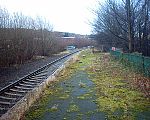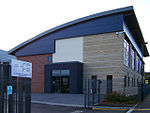The Hillsborough disaster was a fatal human crush at a football match at Hillsborough Stadium in Sheffield, South Yorkshire, England, on 15 April 1989. It occurred during an FA Cup semi-final between Liverpool and Nottingham Forest in the two standing-only central pens in the Leppings Lane stand allocated to Liverpool supporters. Shortly before kick-off, in an attempt to ease overcrowding outside the entrance turnstiles, the police match commander, David Duckenfield, ordered exit gate C to be opened, leading to an influx of supporters entering the pens. This resulted in overcrowding of those pens and the crush. With 97 deaths and 766 injuries, it has the highest death toll in British sporting history. Ninety-four people died on the day; another person died in hospital days later, and another victim died in 1993. In July 2021, a coroner ruled that Andrew Devine, who died 32 years later, after suffering severe and irreversible brain damage on the day, was the 97th victim. The match was abandoned and restaged at Old Trafford in Manchester on 7 May 1989; Liverpool won and went on to win that season's FA Cup.
In the following days and weeks, South Yorkshire Police (SYP) fed the press false stories suggesting that football hooliganism and drunkenness by Liverpool supporters had caused the disaster. Blaming Liverpool fans persisted even after the Taylor Report of 1990, which found that the main cause was a failure of crowd control by SYP. Following the Taylor Report, the Director of Public Prosecutions ruled there was no evidence to justify prosecution of any individuals or institutions. The disaster led to a number of safety improvements in the largest English football grounds, notably the elimination of fenced standing terraces in favour of all-seater stadiums in the top two tiers of English football.The first coroner's inquests into the Hillsborough disaster, completed in 1991, concluded with verdicts of "accidental death" in respect of all the deceased. Families disputed the findings, and fought to have the case re-opened. In 1997 Lord Justice Stuart-Smith concluded that there was no justification for a new inquiry. Private prosecutions brought by the Hillsborough Families Support Group against Duckenfield and his deputy Bernard Murray failed in 2000. In 2009 a Hillsborough Independent Panel was formed to review the evidence. Reporting in 2012, it confirmed Taylor's 1990 criticisms and revealed details about the extent of police efforts to shift blame onto fans, the role of other emergency services and the error of the first coroner's inquests. The panel's report resulted in the previous findings of accidental death being quashed, and the creation of new coroner's inquests. It also produced two criminal investigations led by police in 2012: Operation Resolve to look into the causes of the disaster, and by the Independent Police Complaints Commission (IPCC) to examine actions by police in the aftermath.The second coroner's inquests were held from 1 April 2014 to 26 April 2016. They ruled that the supporters were unlawfully killed owing to grossly negligent failures by police and ambulance services to fulfil their duty of care. The inquests also found that the design of the stadium contributed to the crush, and that supporters were not to blame for the dangerous conditions. Public anger over the actions of their force during the second inquests led to the suspension of the SYP chief constable, David Crompton, following the verdict. In June 2017, six people were charged with offences including manslaughter by gross negligence, misconduct in public office and perverting the course of justice for their actions during and after the disaster. The Crown Prosecution Service subsequently dropped all charges against one of the defendants.







